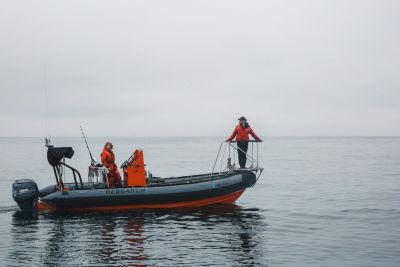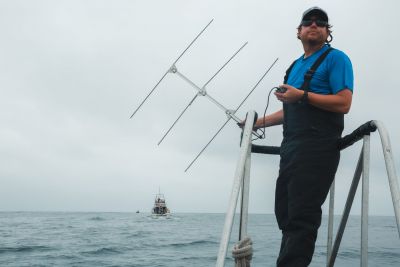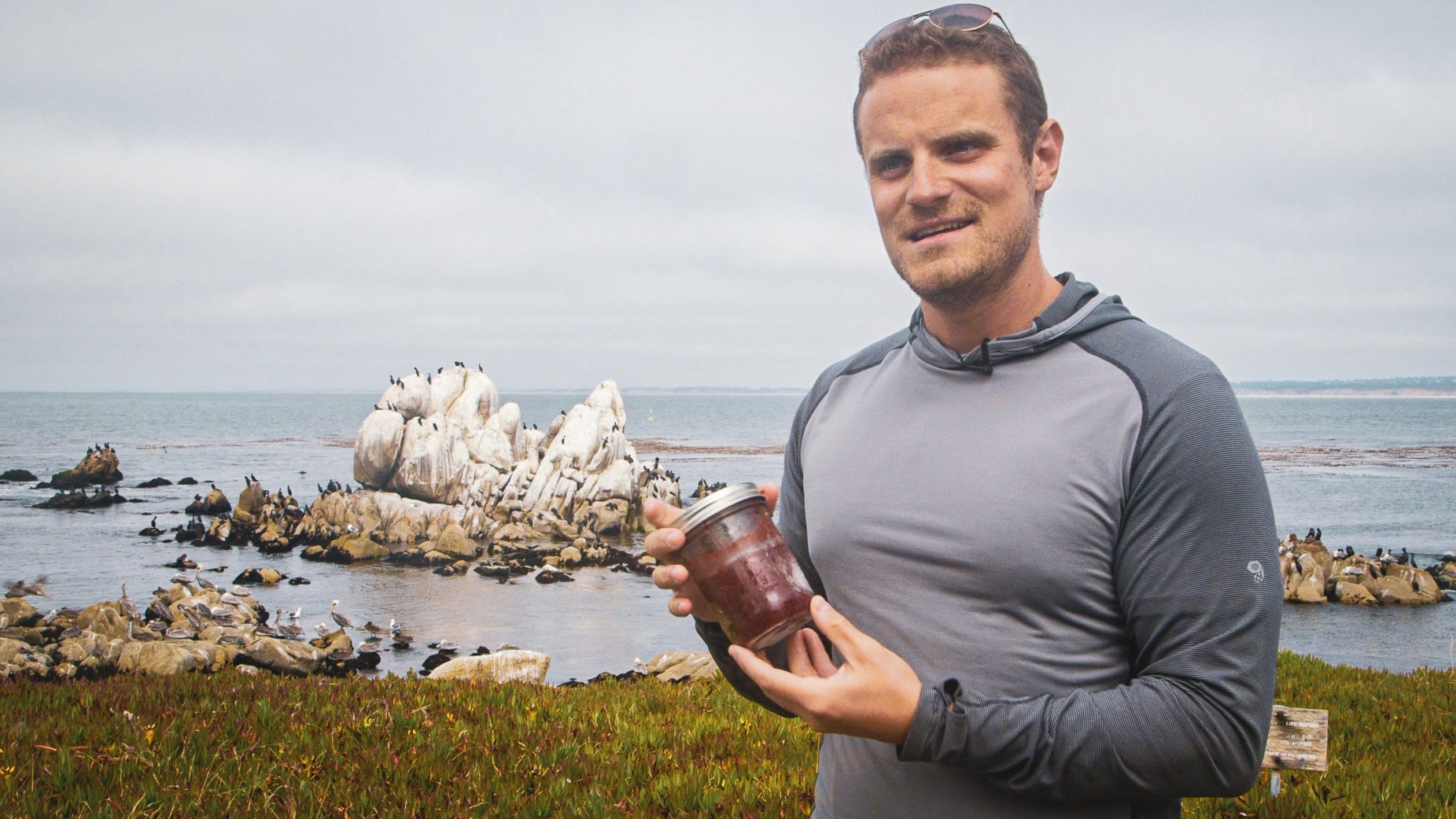Scanning the airwaves over Monterey Bay with a hand-held antenna, Stanford University researchers listen for blue whales – or, more precisely, they listen for the suction tags they’ve stuck on blue whales. The first beep sounds and the captain whips the boat on course, following the quickening signal to find the surfacing giant. The three-person crew must reach the animal before it disappears under the ocean, hidden from sight, radar and study for another 10 minutes. [Note: This research was conducted prior to the novel coronavirus pandemic, and has been on hold in accordance with current guidance regarding research operations.]
Go to the web site to view the video.
The crew in this fast-paced chase hails from the lab of Jeremy Goldbogen, assistant professor of biology in the School of Humanities and Sciences at Stanford’s Hopkins Marine Station. In the Monterey Bay and around the world, Goldbogen and his team employ drones, sound-based mapping equipment, and sensor-packed tags to demystify the lives and biology of rorqual whales – large whales that feed by lunging at groups of prey and filtering water through baleen plates. These include humpback, minke, fin and of course blue whales, which at nearly 100-feet long are the largest creatures known to have ever lived.
“The largest animals of all time can’t be in a laboratory in a building, so we’ve been developing technology that pushes the envelope in terms of understanding how animals operate in the open ocean,” said Goldbogen.
Even the most basic information the scientists can capture about whales could help improve conservation efforts and inform whale-inspired technologies, such as more maneuverable ships. They are especially interested in uncovering how life operates in animals of such extreme size, which leads them to ask surprisingly simple questions: How much do whales eat? How much energy do they spend on feeding? How big do they really get? How do they move? What’s their heart rate?
“Whales are even bigger than dinosaurs were and it’s fascinating that they were able to get this big on the same Earth that we’re on,” said Shirel Kahane-Rapport, a graduate student in the Goldbogen lab. “We study them because, at their size, they face all these complex behavioral and environmental interactions that no other animal has ever experienced.”
Over the years, the lab’s approach has detailed how whales feed, offered an explanation for blue whales’ susceptibility to crashes with cargo ships and revealed never-before-documented swimming strokes in humpbacks .

Image credit: Taylor Kubota

Image credit: Taylor Kubota

Image credit: Taylor Kubota

Image credit: Taylor Kubota

Image credit: Taylor Kubota

Image credit: Taylor Kubota

Image credit: Taylor Kubota

Image credit: Taylor Kubota

Image credit: Taylor Kubota

Image credit: Taylor Kubota

Image credit: Taylor Kubota

Image credit: Taylor Kubota

Image credit: Taylor Kubota

Image credit: Taylor Kubota

Image credit: Taylor Kubota
Research from every angle
Out on the water, the research team consists of about 40 people distributed across a small, motley fleet consisting of large research vessels and small, rigid-hulled inflatable boats. The scientists represent many collaborating institutions, including Moss Landing Marine Labs, Cascadia Research Collective, National Oceanic and Atmospheric Administration and the University of California, Santa Cruz. Together, these people perform an intricate data-collecting dance, the first step of which is whale watching.
Sitting atop one of the large ships, spotters direct the small boats to whales for tagging. If all goes well, the small boat steers alongside a surfacing whale and one of the researchers, wielding a 6-meter-long carbon fiber pole, sticks a tag to the animal. The suction-cup attach tag is designed to stay on for 12-24 hours but can often remain attached for several days. This process is easier said than done, though. The ride is fast and choppy and the researcher doing the tagging must scramble atop a small metal pulpit that juts out past the bow in order to reach the whale.
“You only get a brief second at it but you remember every one of them, every time you put out a tag.”
—David Cade
Former graduate student in the Goldbogen Lab
Blue whales rise and submerge in obvious patterns – typically about 10 minutes underwater and three minutes above – and sometimes give the researchers early notice, thanks to their namesake blue glow. Humpbacks, by contrast, are more challenging, moving faster and less predictably.
“We are so fortunate to get to do this tagging; to be able to be so close to these majestic animals,” said David Cade, a former graduate student in the Goldbogen lab. “You only get a brief second at it but you remember every one of them, every time you put out a tag.”
Ideally, while the tag is being attached, another researcher on the small boat simultaneously obtains a biopsy of the same whale by pricking it with a special arrow, shot from a low-powered crossbow. In place of a standard tip, the arrow’s head collects a small plug of blubber. Almost immediately after it makes contact, the arrow falls into the water and the researchers pick it up. If the biopsy isn’t taken at the same time the tag is placed, the researchers can track the whale down again using the tag’s signal – it’s better to have tag and biopsy data from the same whale rather than one of each from two different whales.
While all this is happening on the small boats, the large boats are conducting projects of their own. They deploy a large drone to record the whales from above, while also activating soundwave-based equipment to map the fish and krill the whales are feeding on below.
From the tag alone, the researchers have video, audio and 3D traces of how the whales move during diving and feeding, which they can match with the acoustic prey maps. The biopsy provides information about the sex of each whale, how they’re related and their hormone levels. Whereas previous records of whale size depended on strandings and hunting, the drone surveys a sample that better represents the current population.
“I use data from an old Norwegian whaling gazette, which is cool but only records whales that were killed,” said Kahane-Rapport. “They probably hunted the biggest whales, so that may have changed the sizes in the population. We want to know what size they are now.”
Altogether, the work of these researchers builds the picture of how individual, living whales grow, move, hunt and sustain themselves down in their watery world.
“You need a team like the one Jeremy’s assembled to have this kind of access to this incredible ecosystem,” said Matthew Savoca, a postdoctoral scholar in the Goldbogen lab. “You have people measuring all these different aspects and together they’ll make a really complete and incredible story. It’s been a fantastic experience and one that couldn’t be done alone.”
It’s a dirty job…
There may be no joy in the world quite like Matthew Savoca receiving a fresh sample of whale poop. Savoca, a postdoctoral scholar in the Goldbogen lab, is collecting these samples – which look unsettlingly similar to a berry smoothie – to verify what whales are eating to assess their health and the health of the ecosystem. Specifically, he is interested in microscopic fragments of plastic that often form as a result of plastic breaking down as it soaks and tumbles in the ocean. If krill and fish consume those microplastics, whales could end up eating plastic-laden prey.

Postdoctoral fellow Matthew Savoca holds a jar containing whale poop, which he gathered from the Monterey Bay. (Image credit: Kurt Hickman)
“These plastics can aggregate pollutants. They can harbor pathogens,” said Savoca. “So, even though they might seem small and harmless, these plastics can actually be vectors for disease and contamination well-beyond the physical harm of the plastics themselves.”
In addition to his scatological studies, Savoca also analyzes the blubber biopsies. If whales are consuming plastic, the blubber may contain telltale chemicals, such as flame retardants or plasticizers – substances added to materials to make them more flexible. Beyond understanding the effects on whales, this research could indicate how much plastic is in the ocean generally.
“A blue whale can filter up to 25 million liters of water in a single day – that’s 10 Olympic swimming pools of water,” said Savoca. “Because they’re sampling enormous amounts of the ocean every single day, they’re doing a lot of the work for us. So why don’t we have them tell us how polluted our waters are with plastic?”
Arts and crafts
Over the years, the complexity of the lab’s custom-made tags has grown. In order to try new tags quickly and affordably, the lab takes what Goldbogen calls an “arts and crafts” approach. They almost always rely on off-the-shelf sensors and a simple, 3D-printed shell and they have collaborated closely with a tag manufacturing company in Australia to bring all the parts together. Tags from research past, now broken or obsolete, earn places on shelves in the lab dubbed, “The Whale Tag Graveyard” and the “Whale Tag Hall of Fame.”
The lab’s latest tag innovation is a heart rate monitor, which detects the electrical signals of the heart via two electrodes embedded in the suction cups. This monitor worked on its very first outing, giving the researchers the first-ever recording of the heart rate of a blue whale as it dove, fed and surfaced.

Retired instrumented tags in the “Hall of Fame” in the Goldbogen Lab at Hopkins Marine Station. (Image credit: Taylor Kubota)
One of the small boats is also the testing ground for a modified version of their prey mapping sonar. Usually, this sonar is deployed from the hull of a larger vessel but if they can get this technology to work on smaller boats, they’ll be able to evaluate prey closer to the whales, which could enable more detailed insight into the creatures’ feeding behaviors.
Amidst all the excitement of inventing new technologies, gathering data out on the water and making fundamental discoveries about whales, the part of this work that Goldbogen treasures most is how it benefits his students.
“The most rewarding thing for me is seeing the students take on these roles and responsibilities and doing such an incredible job,” said Goldbogen. “Often, the one thing I can do is step aside and let them start to lead and build those responsibilities. To see a smile on the face of a student that’s been working on this project for years is really rewarding.”
Goldbogen is also a member of Stanford Bio-X. This research was conducted under National Marine Fisheries Service permit 16111.
To read all stories about Stanford science, subscribe to the biweekly Stanford Science Digest.
Media Contacts
Taylor Kubota, Stanford News Service: (650) 724-7707, tkubota@stanford.edu